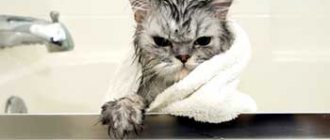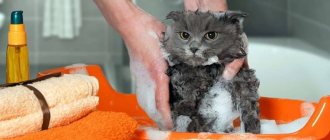All cat owners know that these are very clean animals. After eating or visiting the tray, they carefully lick their coat, and do it very efficiently.
The cat's tongue has a special structure. On its surface there are hard fibers that are located at an angle. Therefore, licking can be compared to combing with a fine-toothed comb. The cat's fur is treated with natural lubricant, which makes the fur coat attractive. When bathing, the balance is disrupted, so frequent water treatments are contraindicated for your furry pet.
Every owner understands that the animal needs to be bathed periodically, but not everyone knows how often this can be done. This procedure is recommended only in certain cases:
- in case of contamination, if the animal is walking on the street;
- once every six months to improve the appearance of the coat;
- It is necessary to bathe the cat from fleas and when infected with parasites (using special means).
But how to bathe a cat if he is afraid of water? Yes, these clean people actually have a very negative attitude towards water procedures (with the exception of some breeds). Nevertheless, sooner or later you have to resort to them. In this article we will try to tell you how to properly bathe a cat so as not to turn this process into torture for you and for the animal.
Owners need to know that the animal is accustomed to all hygiene procedures (including bathing) from a young age. Otherwise, any manipulation related to hygiene will cause a violent protest on the part of your pet.
How to bathe a cat for the first time?
So, we found out that your cat should first become acquainted with water and shampoo at a young age. It should be remembered that a kitten has a vulnerable child’s psyche. The owner’s task is not to instill in the baby a persistent aversion to water and the entire procedure as a whole. To do this, you must follow some rules. The baby’s attitude towards this procedure in the future depends on the very first bath.
A kitten should be accustomed to water from three months. Usually, before this age, his mother washes him out. However, there are exceptions to every rule. If a kitten is very dirty at the age of one month, then it can and should be bathed. You should not carry out the first procedure in the bathroom. A basin is more suitable for this, as it doesn’t look as intimidating to a baby as a huge white bathtub, and it will also be easier to keep him in the water.
You need to pour a little water so that it just reaches the kitten’s tummy. While bathing, talk to your baby in a quiet voice and call him by name. Do not wet the kitten's head from the shower; clean the fur on it with a sponge. Use shampoo for kittens, choosing it based on your pet's coat type. If you can’t purchase it, use any children’s one.
Algorithm of actions when bathing
So, when you have sorted out the frequency and periodicity, and the appropriate remedy has been selected, you can approach the analysis of the bathing process itself.
Follow the following algorithm:
- First of all, pay attention to the air temperature in the bathroom. Heat the air if the temperature is too low, also close the door and avoid drafts. Small kittens cannot regulate their body temperature, so any hypothermia is critical for them.
- Fill a basin or bathtub with enough water. You can determine the optimal water temperature yourself; to do this, dip your elbow in the water. The water should not be cold or hot.
- Prepare additional accessories. First of all, this concerns the towel. It is better to preheat it (using a heater or battery).
- Use cotton swabs around the ears to prevent water from entering the area. You can put special drops into your eyes.
- Place your pet in a container of water. It is better to bathe him with a hose - this will provide a gentle flow of water and prevent splashing.
- Wet the kitten's body, paws and tail. Don't get your hair wet. Lather the wet coat with shampoo using a soft washcloth. Then carefully rinse off the foam. Repeat twice.
- After this, wrap the kitten in a warm towel and dry it slightly. Keep in this state for 5 minutes.
- Then let him out for a walk (carefully ensure that the air temperature is warm and there are no drafts). There is no need to use a hairdryer - this will only scare the animal.
How to bathe an adult cat?
If you have not taught your pet to bathe from a young age, then this procedure becomes much more complicated. However, do not think that your attempt is doomed to failure. Below we will present you with tips and recommendations from experienced owners and veterinarians who will certainly answer the question of how to bathe a cat without scratching it.
To bathe an adult animal, use dry or liquid shampoos for cats; in rare cases, it is allowed to use shampoo for people, as well as baby soap.
How to wash a cat
The condition of the animal's skin is greatly influenced by what you bathe the cat with. This should be a special pet shampoo that best suits the type and length of the coat.
Breeders recommend professional products. Their advantages:
- no flavorings;
- natural composition;
- improve the quality of wool and allow you to wash away dirt well.
If there is no special shampoo and the cat needs to be washed, in exceptional cases and once it is permissible to use shampoo for children under 3 years of age.
Is it possible to wash a cat with regular shampoo?
Cats have drier skin than humans. Therefore, you cannot bathe a kitten or an adult animal with either baby soap or human shampoo. Using regular shampoo will dry it out, which may result in hair loss.
You should also not wash your cat with laundry soap. The product changes the state of the microflora of the skin and dries it out. From such experiments, the coat becomes dry, dull, and allergies may develop.
Shampoos for other animals are not suitable either. Detergents, for example, for dogs can cause serious allergies in cats even after the first use.
Cleansing with dry shampoo
This is the simplest, most gentle way. What are its advantages over the traditional one? Using dry shampoo will not make your cat nervous, and your hands will remain intact.
You can use this product once every six months. In this case, the procedure will not become more complicated than regular combing. But you should know that if it is carried out on a carpet, then it will be quite difficult to clean it from the powder. After rubbing the shampoo a little into the animal's fur, comb it thoroughly.
Alternative option
If it is not possible to bathe your cat at the moment, there is another way to make him clean - dry washing. Today you can find special dry shampoos in pet stores and animal departments. The essence of this “washing” is that the owner does not need to subject his pet to an unpleasant procedure. All that is required is to apply a small amount of product to the fur and comb your pet thoroughly. This option is only suitable for those who have short-haired cats.
Thus, a caring owner should approach bathing a cat with all responsibility. It is necessary to understand that the condition of the animal largely depends on your behavior, and there is absolutely no need to make him once again nervous and anxious.
Preparing for a swim
First of all, trim the cat's claws, this will protect your hands from deep and rather painful scratches. Brush the fur a little so that it doesn't get too tangled during bathing. This is especially important for long-haired animals. All matted wool is cut off if it cannot be untangled.
If a small amount of water is enough to bathe a kitten and you can get by with a basin, then what about an adult animal, which can sometimes be quite impressive in size? Keeping it in a small container is much more difficult; besides, it costs nothing for an adult and strong cat to turn the basin over. How to bathe a cat in the bathroom so that he doesn’t run away during a procedure he hates so much?
The first thing you need to do is protect your pet's ears. To prevent water from getting into them, put a cellophane cap on his head. Place a terry towel on the bottom of the bath so that your pet does not slip and feels at least a little more confident. There should be enough water so that it is just above the animal’s belly.
When starting to bathe your cat, turn off the water, as its noise additionally frightens the cat. Another important factor is water temperature. It should be slightly warm. Dip your elbow into it - it should not burn your skin. When bathing a one-year-old cat for the first time, you expose him to enormous stress, which will be very difficult for one person to cope with. In this case, at least two people will be able to hold it, since the frightened animal screams, breaks out, and scratches. It’s better to do this together, then one person holds the cat and the other washes it.
If you know your pet is too nervous, bathing becomes an additional challenge. In this case, how to bathe the cat? At this moment he scratches and even bites mercilessly. In this case, veterinarians recommend giving him a special cat sedative before the procedure. However, you should not abuse it.
When is bathing necessary?
All cats have different bathing needs:
- cats that do not participate in exhibitions should be washed no more than 2-3 times a year;
- animals with light colors will have to be washed more often;
- Persians are bathed once a month with shampoo and conditioner or dry shampoos are used every 7-10 days;
Often bathing occurs against the will of the cat
- for short-haired exotics - dry bathing once every 3-4 weeks or “wet” bathing once every 2-4 months;
- it is enough to wipe Burmese cats every day with a damp cloth or piece of suede, and wash them only 5–7 days before the exhibition;
- Siamese cats, Bengals and Maine Coons, as a rule, love water treatments themselves.
There are cats that love to swim
Bath procedures are required in the following situations:
- if the pet was dragged dirty from the street (attic, garbage dump) or got very dirty at home, for example, spilled “chemicals” on itself;
- for medicinal purposes (treatment against parasites, treatment of skin diseases);
- for preventive purposes (after contact with an animal whose health condition is suspicious);
- to get a chic look before an exhibition, but this event is best carried out in a salon, where specialists, using special shampoos, will make the color of the coat more saturated, spots and stripes brighter, and lift the coat at the roots for more volume;
- With the help of special means you can get rid of tangles - wool matted after walking in impassable thickets or simply poorly dried after swimming.
Contraindications for swimming
There are several circumstances that need to be taken into account if you are going to bathe your pet:
- You should not bathe pregnant cats so as not to harm the future kittens. If the expectant mother gets too dirty, limit herself to dry shampoo (this does not apply to those cases when the cat likes to bathe herself).
- You should not bathe your cat if he is not afraid enough to avoid swallowing water, hitting his head, or fainting from severe stress.
If you know that your cat is so afraid of water that he will behave inappropriately, do not subject him to this test.
- If your cat is sick, put off bathing until he gets better, otherwise it will only get worse.
- You cannot bathe an animal for 2 weeks after operations or injuries.
- You cannot bathe on a full stomach; at least 4 hours must pass from feeding to bathing.
- Contraindications to swimming are also considered to be a weak heart, aggression, and excessive excitability.
Shampoos for cats
You should not use “human” shampoos to wash your cat. The skin of humans and animals has different pH (acid-base balance of the skin). The pet market offers special shampoos for animals that will not damage the cat’s fur or skin, and the cat will not feel bad after the “bath” by licking the washed fur.
Cats have a strong olfactory memory, so shampoo is needed without fragrance or fragrance. Detergents are even designed for different coat lengths, thicknesses and colors.
Types of cat shampoos:
- liquid - the most common and effective, making the coat soft and silky, easy to comb;
- dry ones are suitable for those cats who are terrified of “wet” bathing;
- Spray shampoos are used in the same cases as dry shampoos.
Liquid shampoos
There are many types of liquid shampoos - cleansing, antiparasitic, anti-matt. You should not use them more than twice a year: frequent use deprives the fur of the protection provided by the sebaceous glands.
For cats with any type of hair, you can choose a special shampoo
For purebred cats of different colors, professional tinted shampoos are purchased - white, red, bronze, black. If shampoo is used for the first time, it is advisable to try it on a small area of the animal’s body to avoid allergic reactions.
To treat problem areas in cats of white and silver color (the inside of the paws, the area under the eyes and around the mouth), as well as to remove fat, yellow spots on the coat, and “tear stone” deposits, bleaches are sold - “8 in 1”, “Iraise Ring” "
Dry shampoos
Dry shampoo is a powder that is applied to the coat and then thoroughly combed out along with the dirt. Makes combing easier, does not dry out the skin and does not deprive the coat of natural protection, and removes static electricity from the coat. It is as effective as liquid shampoos and is suitable for frequent use. With this bathing, water will not get into the ears. Another plus is that after “dry bathing” you do not need to dry the coat.
Prepare in advance a brush for combing and a surface from which combed wool and powder can be collected without problems.
The main thing when treating with dry shampoo is thorough combing.
Shampoo sprays
Such shampoos will not be suitable for your pet if the cat is afraid of “fizzing” sounds or reacts aggressively to them. Sprays make it easier to comb hair and remove static electricity, but in the cold season, in the dry air of apartments, under synthetic blankets and near heating devices, it dries and becomes electrified, clicking, “electric shocking,” frightening the cat.
Spray shampoos relieve hair from electricity and have a pleasant aroma
Sprays have a perfumed aroma that is not found in liquid and dry shampoos.
Video: dry shampoo for cats
How is bathing carried out?
Before putting your cat in the bath, remove all unnecessary objects (towels, washcloths, jars, bottles, etc.) that he could get caught on. Prepare a towel in advance and open the shampoo. Place the cat in the bath, pet him, but hold him tightly, even if he tries to escape. These animals are very cunning, and as soon as your pet feels that your grip has weakened a little, he will immediately make a quick dash and run away.
Do not delay bathing, do not overdo it with the amount of detergents and the intensity of their rubbing. This animal doesn’t have so much fur that it needs to be dealt with in the bathroom for half an hour, and the more thorough the bathing, the more time it will take to bring the natural balance back to normal. Bathing should take no more than 5-10 minutes.
How to bathe a cat without water and shampoo getting into his nose, eyes or mouth? It’s very simple - don’t wash his face. He can handle this job himself just perfectly. Apply shampoo to the cat's back and rub it well. Stand the animal on its hind legs and apply it to the chest, belly, front legs and tail. Lather the shampoo with your hands. It is necessary to wash it off only from top to bottom, and this must be done carefully, because when the cat licks the fur after bathing, it can be poisoned by its residues. Wrap the animal in a towel and hold it in your arms to calm it down a little.
How to bathe a cat: step by step procedure
After preparation, you can begin the procedure: ask a loved one to help you. Washing a cat at home is not as difficult as it might seem at first glance.
It is better to trim your pet’s claws a few days in advance to avoid injury. If your cat is afraid of water, fill the bathtub so that half of its paws are submerged. This way the cat will not feel the risk of drowning.
So, the stages of bathing:
- A cat's body temperature is higher than that of a person, so the water should be 35-40 degrees. Place a rubber mat on the bottom of the bathtub: if the cat feels supported, it will be more calm. Take your pet in your arms, bring it to the bathroom and don’t forget to close the door so that it doesn’t run away! Remain calm, because the cat senses your condition.
- Start slowly immersing the cat in the water, gently but firmly hold it by the back so that it does not run away, give it time to get used to it. If it is scratched, start wetting the fur with your hand, not with a shower head, starting from the tail and ending with the withers.
- Have a helper hold the cat's front paws so that her back paws rest against the tub. Be careful not to get water on your head or ears. It will be better if the cat has its back to the exit so that it does not make an escape plan.
- Now you can wash your cat with shampoo. Apply it to the fur with moderately intense movements, starting from the back, going down to the stomach and paws. Don't forget to soap the tail and neck and head at the very end, as animals like this stage the least.
- Move from the base of the hairs to their tips. Do not tangle the fur too much - this will damage its structure, and tangles may subsequently appear.
- You can distribute the shampoo with your hands or with a special silicone brush that you can purchase at a pet store - it will help you cope with this task better. It is better to wipe the face with a damp sponge without using shampoo.
- It's time to rinse off the shampoo. Turn on the water at low power so that it does not make too much noise, and adjust the temperature. If the animal is in severe panic, discard the shower head and use a ladle.
- Start watering the cat from the withers to the tail, using your hand to remove excess foam. Be careful not to let water get into your ears! You need to rinse off the shampoo very thoroughly so that no foam remains.
Hold your cat firmly but gently to avoid injury. Talk to your pet, even if she is screaming a lot at this moment - hearing your voice, she will be calmer. Show maximum love and tenderness, because at the moment the cat is experiencing a lot of stress.
Flea shampoo
When keeping a cat, great attention should be paid to the regular extermination of fleas. For adult animals, this is much easier to do than for a kitten: you can wear flea collars or use external drops once a month. But such products are not recommended for use on kittens - for them, the dose of chemicals may be toxic.
The most practical and most effective way to rid your baby of fleas is to bathe him with a special shampoo. Depending on the strength of the shampoo, the animal may need to be re-treated. As a rule, clear recommendations are indicated on the packaging of the product. Remember that you should not wash your cat for no apparent reason. She should only be bathed if she is really dirty.
What should you not do while swimming?
As you can imagine, bathing a cat, a procedure that takes only a few minutes, is quite difficult for both the animal and its owner. Therefore, it is necessary to minimize possible irritants:
- Do not open the tap at full capacity.
- The shower should not be turned on at full power.
- Do not use dog shampoo or dishwashing detergent to wash your pets.
- There is no need to pour shampoo from the bottle directly onto the coat, especially dry hair.
- It is strictly forbidden to stuff the animal's ears with cotton - it can cause serious irritation.
Preparation
The procedure must be carried out in such a way as not to harm the animal’s mental state or frighten it. Otherwise, the cat will associate bathing with negative emotions, and subsequent implementations of this event will end in the animal’s hysterics. Before you start swimming:
- Fill a couple of basins with water. During the washing process, it is advisable not to use a shower or tap, as the noise of the water can frighten the animal. It is also better to collect water in the container without a pet;
- Place a rubber mat on the bottom of the basin: this way the cat can grab hold of its claws and not slip. The pet will feel more confident;
- The amount of water you need to fill is approximately the size of the animal’s belly. The temperature should be 35-37 degrees Celsius, in the room no colder than 15 degrees;
- Prepare several towels in advance and place them within reach;
- Prepare a special shampoo. You cannot wash your cat with human products: this causes the skin to dry out and provoke the occurrence of skin diseases.
If the cat has long hair, then brush it before bathing to prevent the hair from matting.
What to do after swimming?
After bathing your cat, you need to dry it thoroughly with a towel, since cats get very cold after such a water procedure, especially if the apartment is not very warm. Many owners consider it lucky if the cat allows him to be warmed in a towel for at least five to ten minutes. Then the animal will most likely break free and begin to lick its coat on its own.
Pre-cover all surfaces where your pet can sit down to lick with towels. They will absorb moisture, and your sofas and carpets will remain stain-free. If your cat continues to tremble violently within five minutes, try to dry it with a hairdryer to avoid catching a cold or even pneumonia.
You already know how to bathe a cat. Now it’s worth talking about combing the fur. When the cat stops licking his fur, pick him up and brush him with a wide-toothed brush. After bathing, the coat becomes very brittle, so combing must be extremely careful.
Cat bathing procedure
Place a container of water at hand level, for example, in a sink. Hold the cat so that it cannot move its paws. Talk kindly to your pet and do everything carefully, without causing pain or discomfort to the animal:
- Gradually lower the cat into the basin. Wet the fur by scooping water into your palm and pouring it over your pet, stroking it as you do so. Never pour water on your head to prevent water from getting into your ears, eyes and nose;
- Lather the animal with shampoo according to the instructions. If you use an emulsion to eradicate parasites, you will need to leave the product on for 5-15 minutes;
- Rinse the animal several times until the water in the basin is clean, also avoiding getting it on the head.
- Carefully remove the animal and wrap it in a towel. Do not squeeze the fur so as not to hurt your pet;
- Leave the cat in a warm room until completely dry;
- Brush your cat when dry.
You can let your pet outside no earlier than 12 hours after bathing.
If you repeat this procedure regularly and carefully, your pet will get used to it and bathing will be a pleasure for him. Get your kitten accustomed to bathing from childhood to avoid problems in the future. Did you like the article? Share with your friends!
And a few more tips
- Under no circumstances should you yell at your pet while bathing; remember that he is under extreme stress; calm him down in a quiet voice.
- Rinse the fur very thoroughly after shampoo - low-quality products can be toxic to the animal.
- If the cat gets dirty with something oily, lubricate the spot with butter before bathing, massage it a little and blot it with a paper napkin or towel.
- When removing fleas using a special shampoo, first wet its neck so that they do not run onto the animal's head.











